Hot stuff in the deep sea Understand article
How do fossils form around hydrothermal vents? Crispin Little describes how he and his team found out – by making their own fossils.
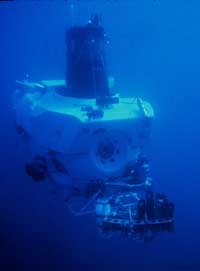
first exploring hydrothermal
vents
Image courtesy of OAR /
National Undersea Research
Program (NURP); Woods Hole
Oceanographic Institution
Research on the deep-sea floor is a serious undertaking. It requires specialised equipment like the famous manned submersible Alvin and very expensive oceanographic vessels capable of operating far from land for a long time. Potential problems are not only technical – ships’ engines malfunctioning or submersible cables tangling, for example – but can also be due to factors beyond anyone’s control: bad weather has scuppered many a well-planned research cruise.
Working on the mid-ocean ridges is even harder, because these are among the most geologically active areas on the planet. Here, new ocean crust is being formed as lava erupts onto the sea floor, accompanied by strong earthquakes (see Searle, 2009). Not only that, but the ridges are also sites of intense hydrothermal activity, with highly acidic vent fluids at 370 °C gushing out of towering mineral chimneys on the sea floor. At these depths, the high pressure raises the boiling point of water enough for it to stay liquid even at these temperatures.
This challenging environment was the setting for our project to study fossilisation in deep-sea hydrothermal vents. Indeed, these challenges were confirmed when we lost an entire set of experimental devices to a major sea-floor volcanic eruption early on in the experiment.
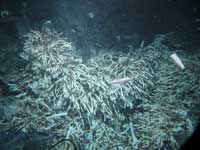
animals found at vent sites
on the East Pacific Rise:
vestimentiferan tube worms,
vent fish and vent crabs. The
shimmery water towards the
top of the image is diffuse
flow hydrothermal fluid
Image courtesy of Crispin Little
Why are we interested in fossilisation at deep-sea hydrothermal vents? The aim of the study was to better understand the evolutionary history of the extraordinary communities of animals that live only at hydrothermal vents. First discovered in 1979 on the Galapagos Rise, these communities have radically changed our view of the diversity of life in the deep sea, partly because their primary energy source is not sunlight, but geochemical energy from hot rocks. The most important compound in vent fluid is hydrogen sulphide, and many vent animals, including giant tube worms (vestimentiferans), vent mussels and clams, depend for food on symbiotic bacteria that live by oxidising this sulphide.
This dependence on geochemical rather than solar energy may have shielded vent communities from major environmental events, like the mass extinctions and global climate change that affected contemporary photosynthesis-based ecosystems. Thus, the evolutionary history of vent fauna is probably very different from that of other marine biotas.
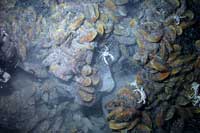
crabs using one of Alvin’s
manipulators
Image courtesy of Crispin Little
The only direct evidence for this history comes from the fossil record. But at present this is sparse, with only 25 examples known from the past 550 million years, and there are fundamental questions about why this is. For example, why do some ancient vent deposits contain fossils, while others in the same state of preservation don’t? There are also significant groups of animals, such as crabs and shrimps, that are abundant at modern vents but which do not appear in the vent fossil record. Why should this be? Is it a case of imperfect preservation, or were these groups not present at vent sites in the past?
To find out, we decided to investigate how modern deep-sea hydrothermal vent animals (molluscs, crustaceans and tube worms – both vestimentiferans and polychaetes) become fossilised at vents. To do this we chose an area on the East Pacific Rise, 500 nautical miles south of Mexico, where scientists have been studying vents for two decades.
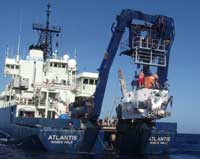
the research vessel Atlantis
Image courtesy of Dr Peter
Auster, NOAA / OAR / OER /
Mountains in the Sea
Expedition 2003
In partnership with colleagues at Woods Hole Oceanographic Institution and the University of New Hampshire, USA, the plan was to use Alvin to deploy specially designed duplicate sets of experimental materials at different hydrothermal vents in three different micro-habitats: the high temperature ‘black smoker’ hydrothermal fluid habitat (up to 370 °C), ‘diffuse flow’ sites where hot fluid and seawater mix (at 10-40 °C, this is where the majority of animals live), and a control site away from active venting (3 °C).
We’d then recover these experimental materials at roughly yearly intervals for transport back to the UK and investigation. The experimental devices consisted of identical titanium mesh cages, inside which were wired a variety of control materials and biological substrates: dried vestimentiferan tubes, vent mussel and clam shells, periwinkle shells and tiger prawn carapaces.
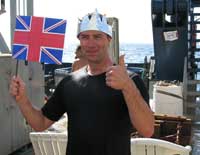
deck of the research vessel
Atlantis after his first dive in
Alvin in December 2007.
Being doused with cold
seawater is traditional.
During the dive, he and his
colleagues deployed a new
set of fossilisation cages at
a vent site; they were
subsequently recovered
around a year later
Image courtesy of Crispin Little
We deployed the first fossilisation cages at two vent sites in May 2005. Unfortunately, our hard work came to nothing – the cages (together with all the other research groups’ scientific equipment) were destroyed by a major submarine volcanic event in the area late in 2005, in which an estimated 22 million cubic meters of lava erupted. Presumably our cages are still there, but covered by several metres of basalt!
We had to restart the project, building new cages and negotiating ship time with our American colleagues. Happily, we have since enjoyed great success. We deployed new sets of fossilisation cages at two different vent sites in November 2006 and December 2007, and recovered them after 373 days and 319 days, respectively. The results are very interesting, and go a long way towards answering many of our questions about fossilisation at hydrothermal vents. For example, we now know that fossilisation is very dependent on exactly where the remains are located around the vent.
In our experiment, fossilisation by the growth of sulphide minerals on the biological materials (vestimentiferan tubes, periwinkle, mussel and clam shells) only occurred in the high-temperature areas of the vent sites, or where the vent changed over time – for example, where a diffuse flow vent turned into a black smoker during the experiment. Sulphide mineralisation did not generally occur at diffuse flow sites, although mollusc shells suffered considerable dissolution here, or at control areas away from active venting. The implication is that the fossils found in ancient vent deposits reflect only the parts of those communities that lived at the higher-temperature areas around the vents.
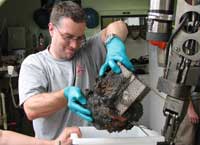
pair of fossilisation cages
from Alvin’s collection
basket (Alvin’s claw can be
seen on the right), recovered
from 2.5 km down on the sea
floor. After around a year in
the high-temperature vent
fluid, the cages have a pyrite
chimney growing through
them
Image courtesy of Crispin Little
We found that the mollusc shells and tubes acted as simple substrates for the growth of pyrite (iron sulphide), with mineralisation occurring on both shells and tubes. This is exactly what we might expect from the preservation of vent fossils in ancient vent deposits.
We also discovered that the apparent bias towards the fossilisation of worm tubes and mollusc shells is a real phenomenon and reflects how well the various biological substrates resist chemical dissolution in the vent environment, which puts them under high pressure due to depth and exposes them to hot, acidic vent fluid. Thus, no shrimp carapaces remained in any of the ten cages, including those from the control sites away from active venting. Vestimentiferan tubes, by contrast, proved resistant enough to decay to become fossilised.
The organic coating of mollusc shells, called the periostracum, protects them to some extent from dissolution and makes it more likely that shells with thick periostracal layers will be preserved as vent fossils, particularly as the periostracum on its own can be mineralised. The implication is that crustaceans such as crabs and shrimps were present at hydrothermal vents in the past, but were just not preserved.
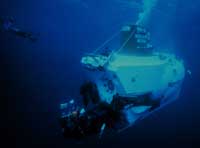
maximum depth of 4000 m
(mean ocean depth is
3800 m)
Image courtesy of OAR /
National Undersea Research
Program (NURP); Woods Hole
Oceanographic Institution
Our results are consistent with observations from ancient vent sites and let us better interpret the fossil record of vent communities. From this, we now know more of how vent fauna evolved, because we now understand how organisms are preserved in these environments, including the extremely rapid pathway to fossilisation – less than a year.
However, because fossilisation at vent sites happens so quickly, we still don’t fully understand the very early stages of mineralisation of shells and tubes by pyrite, and future experiments should have shorter durations – in the order of a few months. Ship time and submersible seats, anyone?
Acknowledgement
This article was first published in Planet Earth, a free magazine about natural and environmental science, published by the UK’s Natural Environment Research Council. See Little (2009).
To subscribe to Planet Earth, email requests@nerc.ac.uk.
References
- Little C (2009) Hot stuff in the deep sea. Planet Earth Winter, 18-19. http://planetearth.nerc.ac.uk/features/story.aspx?id=576
- Searle R (2009) Holes in the crust. Planet Earth Autumn, 28-29. http://planetearth.nerc.ac.uk/features/story.aspx?id=511
Review
This is a superb article that describes the process of scientific investigations in the extreme environmental conditions of hydrothermal vents. Suitable for students aged 12 to 18, it could be used in lessons on biology in extreme environments, adaptation, life in space or mineral resources. For example, it could be used to discuss the probability of life on other planets.
Suitable comprehension questions include:
- What kinds of organisms are found near deep-sea vents?
- How can organisms survive at these depths without sunlight?
- What do these organisms eat?
- What sorts of minerals are found near the hydrothermal vents?
The multidisciplinary aspect of this research makes the article very useful when discussing how science really works.
Eric Demoncheaux, UK





